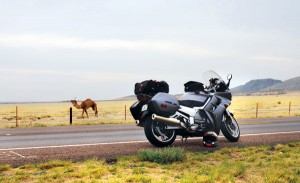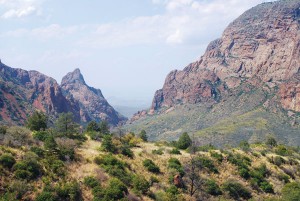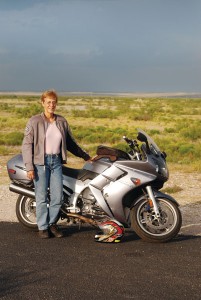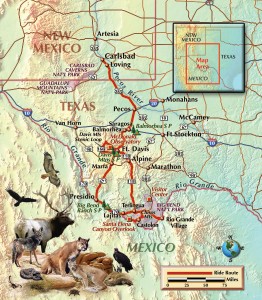story and photography by Laura Melvin
Three old riders, two motorcycles and one honeymoon, a week before the wedding. It doesn’t take much to justify a road trip, so Eleanor and I took Lew, her soon-to-be husband, on their honeymoon.
We left Carlsbad, New Mexico, on Highway 285, heading to Big Bend National Park (named for the great U-turn the Rio Grande River makes in southwest Texas). I thanked Lew (too) many times, with a laugh: “Thanks for inviting me. I haven’t been on a honeymoon in a very long time.” Though I had a separate motel room, for the next five days Lew had to endure hours of two women clucking over him—except when we were telling him what to do or ignoring him. It was enough to test the love of any rider.
In Pecos, Texas, we stopped at La Nortenga’s on 3rd Street, a tamale factory with carryout. “Carryout” means there are tables inside but no public restrooms. Eleanor held our orders of green and red chili tamales (an advantage of riding two-up), and we rode over to a truck stop for our 10:30 a.m. lunch. It didn’t seem polite to ask Eleanor to hold the tamales any longer when we could eat the entire load. Highway 17 south from Pecos crossed flat, uniform desert, but after a short ride west on Interstate 10 and then south on Highway 18 at Balmorhea, the world began to rise and fall, and the desert wore early spring flowers.
West of Ft. Davis is a 75-mile scenic loop up through the Davis Mountains. The McDonald Observatory, located on the loop, is home to the Hobby Eberly Telescope (HET), the world’s largest publicly accessible telescope. Check the schedule for Star Parties at the Public Observatory.

Highway 17 runs south from Ft. Davis to Marfa, the glider capital of the United States, and a landmark for James Dean fans. The 1955 movie, Giant, staring James Dean, Rock Hudson and Elizabeth Taylor, was filmed in Marfa, and the El Paisano Hotel was home base for that famous cast and crew. Even a quick trip through the beautiful hotel will include a stop in the lobby, where autographed photos of the cast are displayed. Heading south from Marfa on Highway 67, we stopped for a photo op with a camel grazing in the prairie.
Highway 67 dead-ends at Presidio on the Mexican border. From Presidio, Highway 170 flows east with the Rio Grande, twisting and turning over roller-coaster hills cloaked in nonstop natural beauty. I know from fifth grade geography that the Rio Grande is the border between the USA and Mexico. But standing on the riverbank, it was hard to wrap my mind around the fact that I could literally throw a rock across the muddy waters and it would land in a foreign country. Economics, opportunities and governments may depend on the side of the river upon which you stand, but Mother Nature laid a beautiful spread across the entire region, ignoring man’s artificial lines on paper. The ocotillo, yucca, Texas bluebonnet and prickly pear were dressed in their spring blooms. A Peregrine Falcon flew between the two bikes and across the river. Along the road we passed several javelinas, a piglike animal with a nasty personality.

In Terlingua, seven miles west of Big Bend National Park, we checked into a modest motel that was an adequate base. But our rooms were several hundred yards from the highway, every inch of which was gravel studded with rock, some the size of my fist, lying in wait in the loose gravel to snatch my bike’s handlebars and drop me…like a rock. Lew and Eleanor ride a low-slung cruiser that is relatively light. My bike is a heavy 609 pounds (plus gear) with a high center of gravity and a 31-inch seat, over which I drape a 30-inch inseam with only 135 pounds of me to push it closer to the ground. So, I was not happy riding up and down that graveled, rocky road several times each day. When riding on gravel, turns should be carefully planned hours in advance; stops need to be calculated days ahead of time! At least, that’s my story. Of course, I couldn’t push my bike backward across that rocky gravel, so Lew and Eleanor were my reverse.
I’m from flat and rock-barren Florida so I have a lot to learn. For example, on this trip I learned what happens when I accelerate up a steep incline of rock, gravel and sand to access a side road and then make an unplanned stop halfway up to avoid a truck dragging a long trailer that’s just pulled off the highway onto that same side road. I learned that it’s fairly easy for three people to pick up my Yamaha FJR1300; that a PLF (parachute landing fall) is a good approach for bike falls; and that it’s possible to drop my bike on gravel without trashing it. If I’d had the guts and forethought, I may have been able to avoid the drop by speeding up and making a 90-degree turn on the steep incline; if that didn’t work, the drop would have been more spectacular and I would have learned different lessons.

The area caters to tourists, and there are various campgrounds and motels available. Dinner underground at La Kiva is interesting, the site photogenic. Los Paisanos is a restaurant favored by the locals for its excellent Mexican food in a small, modest structure. Try the green chili chicken enchiladas, served flat with eggs on top.
The weather was perfect, except for the one hail-studded thunderstorm. We were finishing dinner at the filling station/ quick-stop/café a few miles from the motel when we realized the rumbling sound was not Harleys. We decided to make a run for it, and the bottom fell out of the sky within the first half-mile. The hail was small but it still stung, the rain was heavy, and the lightning much too close as we hurried back across the long rock and gravel road. The doors to our motel rooms opened onto a narrow covered walkway, a walkway now packed with motorcycles and riders enjoying the storm from their dry lounge chairs. Lew found an opening and nosed his bike right up to the wall; the crowd of riders cheered over the cracks of thunder and bullets of hail on the tin roof. Because of that gravel thing, I was tentative about sandwiching my bike between the many other (dry) ones; I stopped to consider my dilemma under the ledge of the walkway and got a good dousing. With several extra gallons of water down my neck and loud encouragement from the other riders, I slipped my bike into a crevice without dropping it. As we peeled off wet gear, our 15 new best friends included us in their banter.
My strongest impression of Big Bend National Park is BIG. The park covers 802,541 acres; the Rio Grande runs 118 miles along the park boundary and Mexico border, cutting three sets of dramatic canyons. Within its enormous bulk there are well-maintained, paved roads, plus a generous number of routes outfitted in rock and gravel for dual-sport bikes. You can pick up a booklet at the Park Visitor Center that describes and maps the roads. Throughout the area is a cornucopia of nature with ecosystems that change with a twist in the road—the river with its canyons and flood plains; the Chihuahuan Desert where it can be 115 degrees midday in the summer; and the Chisos Mountains, reaching to 7,825 feet to create a green island in the sea of desert. Trails you can hike in your motorcycle boots include the Santa Elena Canyon and the Window View at Chisos Basin.

All of this beauty remains incredibly undeveloped, though not for a lack of trying on the part of man. There are scattered shells of adobe buildings and more modern structures slowly returning to dust. A recent attempt to tame this vastness is the 25,000-acre private development that includes the old town of Lajitas. Lajitas sits 21 miles west of BBNP and is billed as “the ultimate hideout” with its own airport, golf course, equestrian center, tennis courts, spa and high-end shopping—a place to get away from it all in comfort, amidst the splendor of nature. But even when you’ve plopped down in the lap of luxury in the middle of a roughshod desert, you still need a beer-drinking goat, so stop by the Lajitas Trading Post and pop the top on a longneck for Clay Henry III and watch the goat guzzle.
Near Terlingua is a ghost town of crumbly adobe buildings that have been reclaimed by two-legged desert rats—some artists, some dropouts—free spirits all. “The Porch” is the gathering place—to drink a beer, pick a guitar, discuss politics, watch the sunset or the moonrise.
On Day 5 we packed up and traveled north on Highway 118 for a breakfast stop in Fort Davis at the drugstore, downstairs in the Old Texas Inn. Then it was time to head home. There’s something contagious and magical about the vastness of Big Bend that spurs the need to return to ride, hike and breathe, though, and there’s always the chance for a photo op with a camel or beer-drinking goat.
P.S. In spite of me, Lew and Eleanor enjoyed their honeymoon and got married the next week.
Info Sources
Big Bend National Park, P.O. Box 129, Big Bend National Park, Texas 79834; (432) 477-2251; www.nps.gov/bibe
Chisos Mining Company Motel, Terlingua, Texas; (432) 371-2254; cmcm.cc
Fort Davis, Fort Davis Chamber of Commerce, P.O. Box 378, Fort Davis, Texas 79734; (800) 524-3015; www.fortdavis.com
Ghost Town, Terlingua, 100 Ivey Street, P.O. Box 362, Terlingua, Texas 79852; www.historic-terlingua.com
Lajitas, The Ultimate Hideout, HC 70, Box 400, Lajitas, Texas 79852; (432) 424-5000; www.lajitas.com
Los Paisanos Mexican Restaurant, (432) 371-2101
McDonald Observatory, Fort Davis, Texas; (877) 984-7827; http://mcdonaldobservatory.org
[From the November 2008 issue of Rider]






